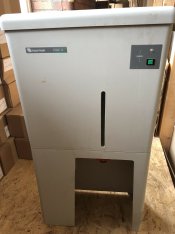Huss
Member
Wait, what? You drink it but don't want to wash the film in it?

It's well water, from the nearby community centre. Drunk and enjoyed by a great many. Partially, I think, for its mineral content. But it's definitely not filtered and purified like town water
What I've found is that I can wash in any old water at all -- as long as the final PhotoFlo (equivalent) rinse is mixed with distilled or deionized water.
Not applicable to this particular use, but I think I would limit this advice to normal black and white film - colour slides or negatives might be a bit less tolerant.What I've found is that I can wash in any old water at all -- as long as the final PhotoFlo (equivalent) rinse is mixed with distilled or deionized water.
@MattKing This is a thread about Cinestill Df96 monobath -- a strictly B&W chemical. Why would anyone with any sense try to generalize anything said here to include dye-image films? But beyond that, what makes you think C-41 and E-6 commercial processes weren't tested against a pretty broad range of potable water supplies? After all, having to constantly replace filter cartridges cuts into the profit margin of a mini-lab.
Extending that, If you were really interested in getting repeatable, consistent results, you wouldn't be using a monobath
If you one shot it and control the temperature and agitation exactly then yeah. When I started doing b&w development I was very keen on monobaths, but that cooled off once I saw the repeated, repeatable results that I was getting from one shot rodinal or one shot d76. I just haven't managed to get the same consistency from df96.A single use monobath tuned for a specific film can give repeatable and consistent results. No?
Donald,@MattKing This is a thread about Cinestill Df96 monobath -- a strictly B&W chemical. Why would anyone with any sense try to generalize anything said here to include dye-image films? But beyond that, what makes you think C-41 and E-6 commercial processes weren't tested against a pretty broad range of potable water supplies? After all, having to constantly replace filter cartridges cuts into the profit margin of a mini-lab.
One shotting DF96 would get expensive, I'd think though.
Economy and convenience offered by DF96 can't be matched by a single use monobath.
Donald,
Thus the qualification to my remark - which was also in response to your using "any old water at all", not "any old potable water at all".
I think you will find that the commercial C-41 and E-6 processes do have strong recommendations/warnings attached to them about water quality.

Without a too detailed chemistry explanation, how does mono bath work?
Thank you for explaining.Short version: a monobath is developer and fixer mixed together. Both processes proceed at the same time, so the rate of fixing limits the amount of development. Obviously, the solution has to be alkaline (most developing agents won't work in an acidic solution), but fortunately, fixers generally don't care (they've traditionally been acidic because they used to mix gelatin hardeners into them, which require an acidic solution).
unless there’s some ‘clever’ chemistry where a reaction takes place at the end of development that somehow ‘switches on’ fixing.
Thanks Donald. The more I learn about this the more I want to know about the chemistry. Some reading is necessary and will ultimately help me get the best out of my ‘wet‘ photography.If that were the case, I couldn't have made a monobath from HC-110, Ilford Rapid Fixer, and household ammonia (to bring the pH up -- borax or washing soda likely would have worked, but I had ammonia handy). No trick chemistry, just a matter of balancing the rates of the two processes. With Df96 you increase temperature to speed up development, and increase agitation to speed up fixing -- hence why pushing requires developing warmer and reducing agitation; you're using both "knobs" to get more development done before the fixer takes away the halide.
All appearances indicate that it is Donald's earlier work that Cinestill based their monobath on.Thanks again Donald.
PS Are you a chemist?
| Photrio.com contains affiliate links to products. We may receive a commission for purchases made through these links. To read our full affiliate disclosure statement please click Here. |
PHOTRIO PARTNERS EQUALLY FUNDING OUR COMMUNITY:  |